Day 1 of a three day Autumn Tour in Norfolk today. We spent the day up on the north coast. The forecast was poor, with a wind warning out, but it turned out to be nowhere near as bad as we feared. It was a bit gusty, but not as bad as recent days, and it was mostly dry, apart from a squally shower which almost passed us by as we ate our lunch under cover and some rain just as we finished this afternoon. Certainly another day well worth going out!
Heading east along the coast road this morning, we called in at Kelling first. As we walked up along the lane, a Robin was singing from the fir tree by the school and a few Goldfinches dropped down into the hedge beyond. There were several Chaffinches in the taller trees further along, but when we got to the copse, all was quiet.
A couple of House Martins flew over us, heading west, presumably birds on their way to Africa now. A flock of Linnets was feeding down in the stubble field beyond and flew round as we passed, but there didn’t seem to be many birds in the hedgerows. It was rather cool and breezy.
There were quite a few gulls on the Water Meadow again – mostly Black-headed Gulls, either swimming on the pool or loafing on the bank. A few Herring Gulls of various ages were with them and an adult Lesser Black-backed Gull dropped in too. The resident pair of Egyptian Geese were in with the gulls on the grass and a noisy mob of Canada Geese flew in and landed on the water.
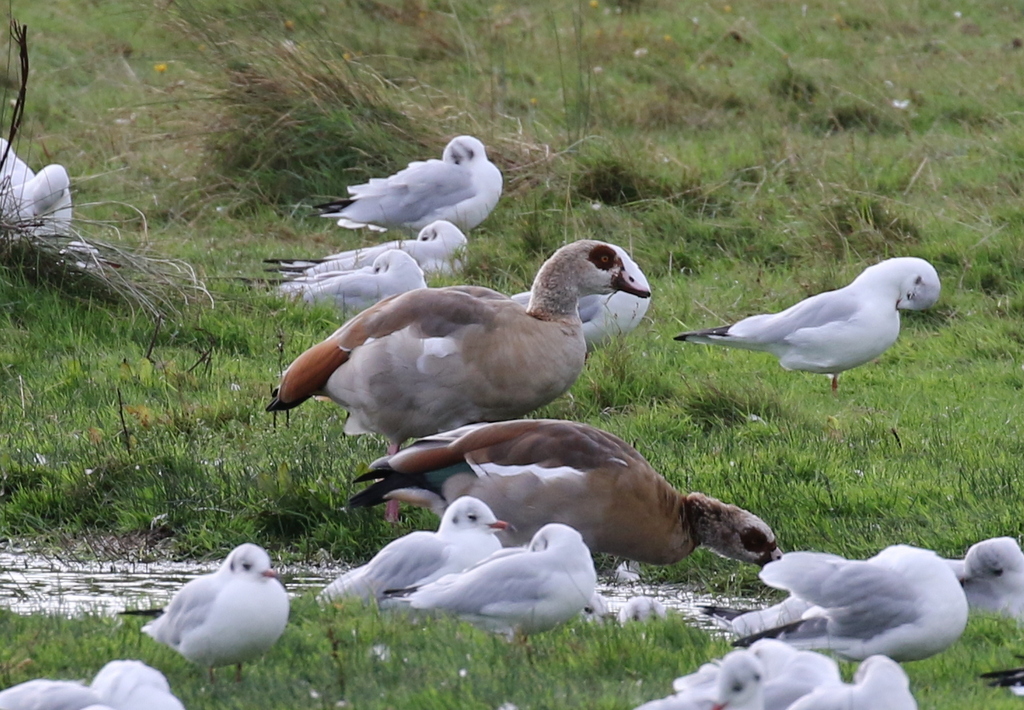
A Common Snipe circled over the Water Meadow but seemed to change its mind and headed out over the Quags. It seemed to change its mind again when it felt the wind and cam back in, landing in the long grass on the far side of the pool. When we walked to the corner, we could just see it lurking in the grass, watching us, before it flew up again and away.
Down along the track to the beach, a Reed Bunting flew across and dropped into the reeds where it disappeared. Walking up the hillside, a Meadow Pipit flew up out of the grass, but dropped straight back in again further back. There was a big flock of Goldfinches in the bushes and feeding on the ground in the shelter of the old sand pit.
As we walked up to the gun emplacements, we scanned out to sea. A couple of Sandwich Terns were battling into the wind offshore. Then a couple of Gannets flew past, quite close in, banking and tacking downwind, dark slaty grey juveniles. For the next couple of minutes there was a steady trickle of Gannets passing offshore, adults white with black wing tips and some in between.
It was windy and exposed up here on the hillside, so we headed back down. As we walked back towards the Water Meadow, a small warbler flicked out of the brambles ahead of us and dropped straight back in again. Unfortunately we didn’t get a good look at it – we were looking into the sun – and it didn’t emerge again.
Along the cross track, we stopped to scan the muddy ditch which runs across the Quags. While most of us were scanning the edges further back, one of the group noticed a Common Snipe crouching behind a piece of plastic sack down in the grass right in front of us. It pretended it wasn’t there for several minutes before eventually flying off.

We had a bit more luck finding birds in the hedges in the lane on our way back – perhaps because it brightened up a bit and we could even feel the warmth of the sun. First, a Common Whitethroat appeared in the brambles, where we watched it eating blackberries. Then we came across a Willow Warbler flicking around low in the bushes along the edge of the field. Further up the lane still, a Chiffchaff was singing rather half-heartedly from a holly tree.
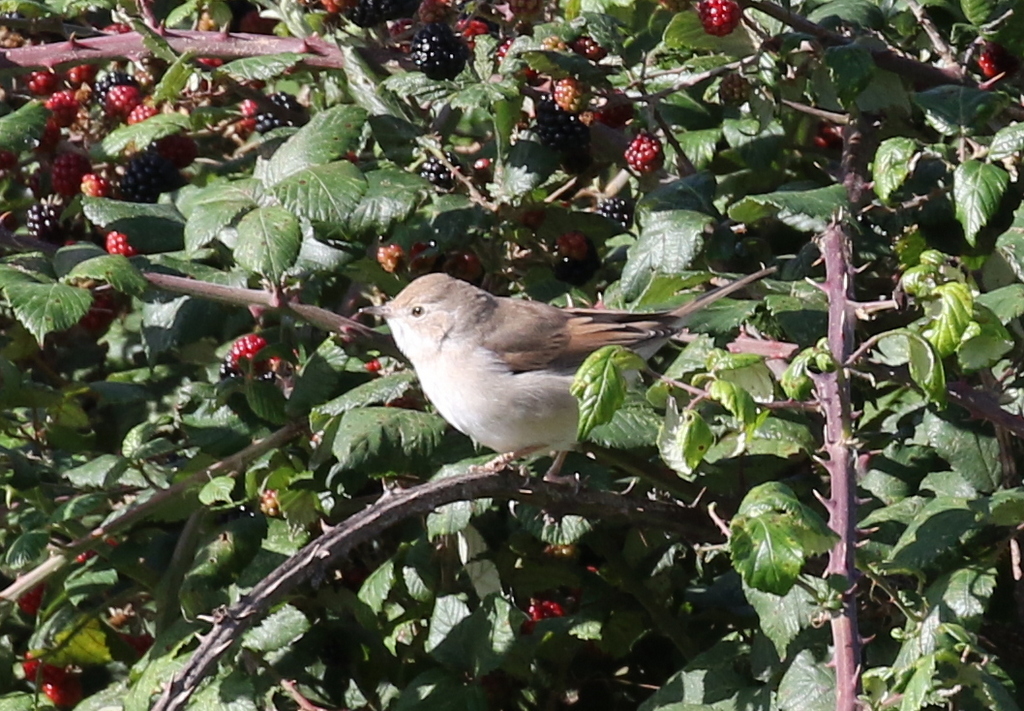
There was a tractor rough cultivating one of the stubble fields beside the lane. A Red-legged Partridge ran away from us up the edge of the field. A Brown Hare was hiding in the longer green growth out in the middle, looking just like a clod of brown earth, and the tractor flushed a second Hare as it worked its way round.
Several Black-headed Gulls were following the tractor, landing in the cultivated strip behind, and we could see a few larger gulls too which were feeding out of view higher up the field but flew up as the tractor passed. A 1st winter Mediterranean Gull flew in to see what was happening, we could see its black outer primaries and secondaries, contrasting with silvery grey midwing panel and mantle, as it flew past us and disappeared up over the rise in the field.
Back to the car, we made our way back west. We stopped at Iron Road next and had a walk up to the pools. There were a few Greylag Geese here, and a couple of Lapwing, but it looked from the recent tyre treads heading through the gate like someone had been in there recently.
We walked back and made our way round towards Babcock Hide. A few Swallows flew past over the grazing marshes, more birds on migration, heading off back to Africa for the winter. A big flock of Egyptian Geese were out on the grass with the Greylags. A group Curlew circled over – several dropped down onto the pool in front of the hide, but the rest continued over towards the grazing marshes by the East Bank.
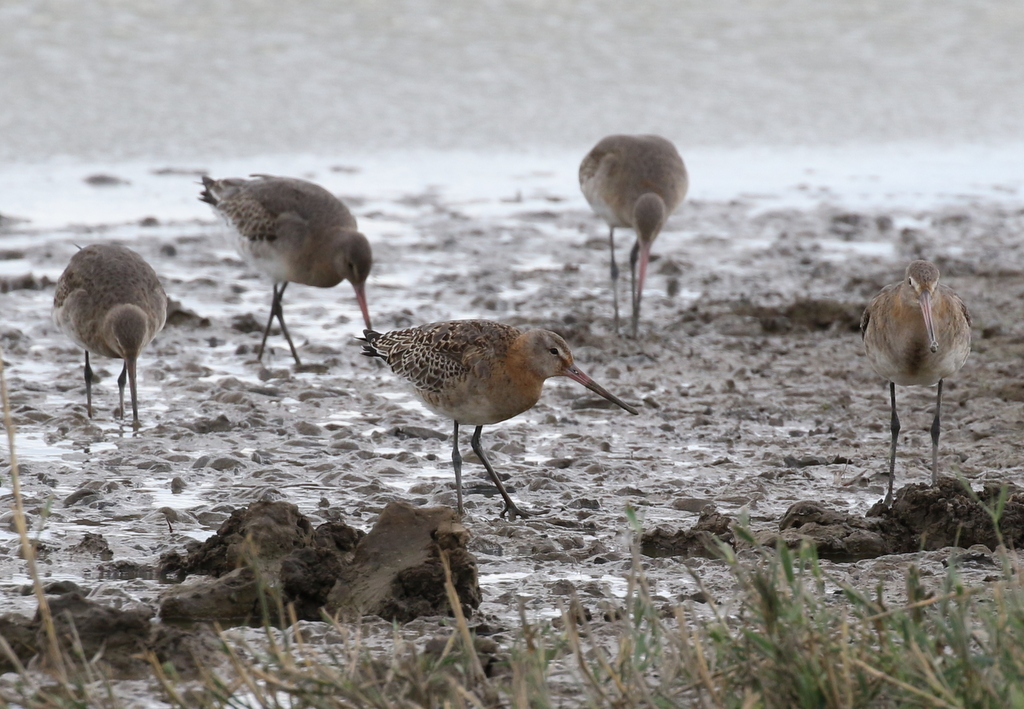
When we opened the flaps in the hide, the first thing we noticed was a flock of Black-tailed Godwits roosting and preening in the water in front. Several more were feeding on the mud nearby. Several were brightly coloured juveniles, with an orange wash around the neck and across the breast, which marks them out as birds of the Icelandic race. Amazing to think they were raised up in Iceland just a few weeks ago!
There were several Ruff on here too, further back, and a few Curlew asleep towards the back, possibly the ones we had seen fly in earlier. Several flocks of Lapwing flew past – possibly just local birds moving, but perhaps they had just arrived from further afield?
We saw a nice selection of ducks on here today, Mallard, Gadwall, Teal, Wigeon, one or two Shoveler, and 12 Pintail. The Fulvous Whistling Duck with the large mob of Greylags doesn’t count – it is an escapee from someone’s collection, that seems to think it is a goose! Behind the Greylags, a family of five Pink-footed Geese obviously did not want to mix with their commoner cousins. Possibly freshly returned from Iceland, the goose and three full-grown juveniles were busy feeding while the gander stood guard nearby.

A Sparrowhawk flew over the back, keeping low, and disappeared behind the reeds. Then we noticed a Hobby over towards Little Eye. Several times it flew up before stooping vertically down at something below, at which point each time we lost sight of it. Then it gave up and flew powerfully low over the grass towards us, before turning and heading across over the grazing meadows just to the south of us.

As if that wasn’t already enough, the highlight from our stop in Babcock Hide was the Otter which was feeding in the deeper water in the back. It was very active, diving repeatedly. Twice we saw it surface with a large fish. The first time, it swam with it across to one of the reedy islands and we thought it would hide in there for some time, eating. But just a few minutes later, it was back out fishing again. The next time it caught what appeared to be an even larger fish. It swam across to the same island, but a minute later reappeared and swam across with the fish still in its jaws, disappearing round behind the reeds along the edge.
When the Otter finally disappeared, we made our way back to the car and drove a little further along, to Walsey Hills. As soon as we got out of the car, we could see the two Spotted Redshanks out on Snipe’s Marsh. They were feeding very actively in the shallow water amongst the mud and cut reed stems. One was still largely in juvenile plumage, dusky grey, but the other was more advanced in its moult to winter plumage, whiter below and paler silvery grey above. We could also see their long, needle-fine bills.

There was a nice selection of other birds on here too. Four Green Sandpipers were feeding around the edge of the mud at the back. A single Common Snipe was very well camouflaged against the cut reeds. There were also a few Little Grebes and a single Tufted Duck out on the water.
It had clouded over a bit more now, so we decided to head round to the beach car park and use the shelter for lunch. It was a good move, as we could see a squally shower coming in, which mostly passed to the south of us, although we just caught the trailing corner of it. There were a few Sandwich Terns offshore and while we were eating lunch we spotted two Arctic Skuas flying in to chase them. We watched the ensuing aerial dogfight for a couple of minutes before the skuas eventually realised they weren’t going to be able to steal a free lunch and gave up. One or two more Gannets flew past, too.
After lunch, we drove round to the Visitor Centre and then walked out onto the reserve, to the hides. A quick look out from Avocet Hide revealed not very much on Whitwell Scrape – a handful of ducks and a single Green Sandpiper in the vegetation in the far corner.
There were more birds on Simmond’s Scrape, so we moved straight on to Dauke’s Hide. There were six Dunlin on here, picking around on the muddy edges of the islands, juveniles with black-streaked bellies. We could see a few more Black-tailed Godwits, a couple of Ruff and a Curlew. There were plenty of ducks too. A Marsh Harrier flew in and circled over the reeds at the back.
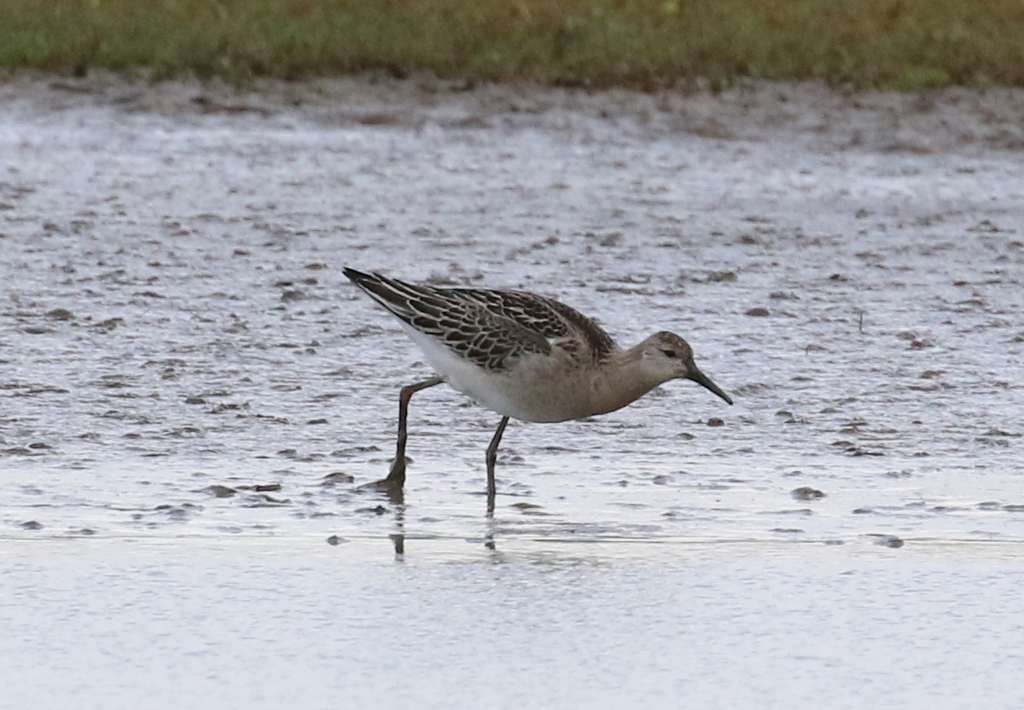
We looked across to Pat’s Pool and could see even more birds on there. There were several juvenile Ruff with a couple of Redshank right down at the front. A male Ruff was strikingly larger than the several females with it. There were lots of Black-tailed Godwits on here, and a single Green Sandpiper right at the back on the mud.
There were a couple of Dunlin on Pat’s Pool too, but they were mobile, flying round nervously in the wind. When they landed at one point, with the godwits, right over the far side, in front of Bishop Hide, a third small wader was with them. It was noticeably brighter marked above than the Dunlin, with obvious tramlines, clean white below, with a comparatively short beak. When it turned, we could see its streaked breast was neatly demarcated from its white belly. A juvenile Pectoral Sandpiper!
We had just got the Pectoral Sandpiper in the scope, when someone came round from Teal Hide to let us know they had seen it too. It was distant at first, so after a quick look we made our way round to Teal Hide where we had a better view. All the small waders were still rather easily spooked, and eventually it came a bit closer. We had a really good look at it through the scope.

There have been quite a few North American waders turning up in UK in the past week or two, courtesy of the active Jetstream. Presumably this Pectoral Sandpiper had most likely come from there, rather than Eastern Siberia, where they are also found. There was also a juvenile Bar-tailed Godwit on here, but it rather played second fiddle to the Pectoral Sandpiper.
When the Pectoral Sandpiper flew back and landed on the mud over near Bishop Hide, we headed round there. It was only a short distance beyond the visitor centre, where the car was parked, anyway. We had an even better view of it from here, when it flew out and landed in the middle just behind the roosting gulls.
There are always lots of ducks loafing on the bank between the hide and the scrape, and we had great views of an eclipse drake Wigeon which was bathing in the channel in front of the hide, before climbing out onto the grass beyond.
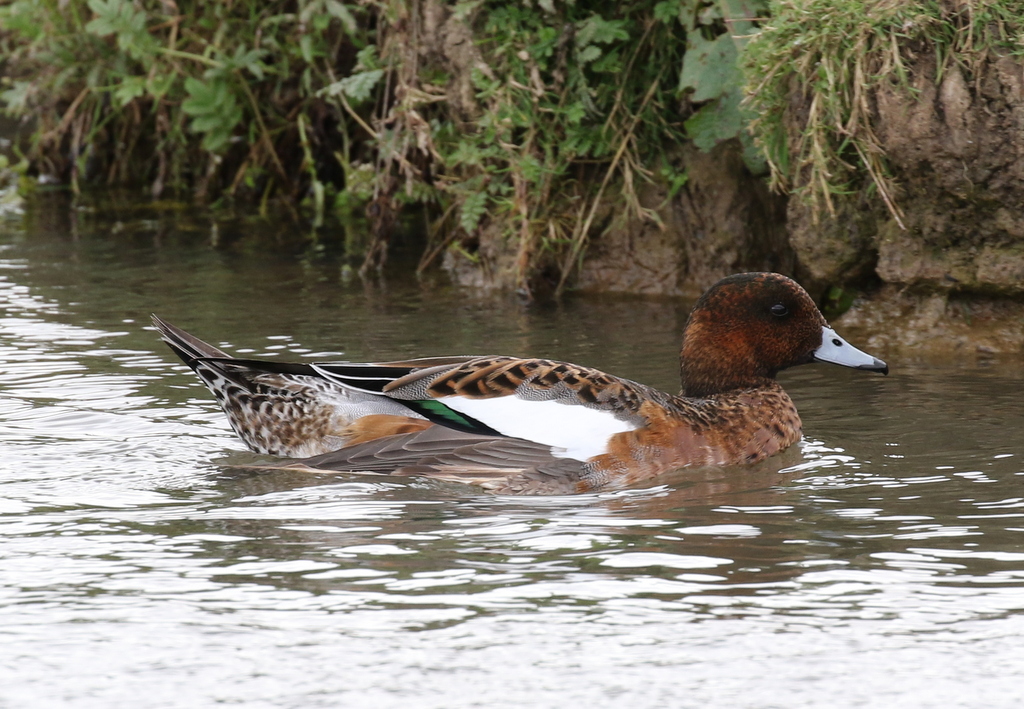
Eventually, we managed to tear ourselves away from all the action here. As we walked back towards the visitor centre, a male Marsh Harrier flew in over the road and dropped down into the reedbed. A small flock of Pink-footed Geese flew past, and as they got closer we could hear their yelping calls. Probably more birds just returning from Iceland, coming here for the winter.
We had stayed rather longer than intended at Cley this afternoon, with all the excitement over the Pectoral Sandpiper. We still had just about enough time to call in quickly at Stiffkey on the way back, but as we drove west we could see dark clouds and when we got there it was raining. We decided to save that for another day, and try our luck elsewhere.
As we drove up to the church, the usual perches where the Peregrine likes to stand were empty, but then we noticed it a little further along, on the stone ledge. We got out of the car and set the scopes up and were treated to close up views of it. It was looking around, checking out the traffic passing below and the people walking through the churchyard, seemingly unphased by it all, blinking occasionally.

It was a nice way to finish off what had been a great first day out. So much for the dire predictions of the Met Office! Let’s see what tomorrow brings…
















